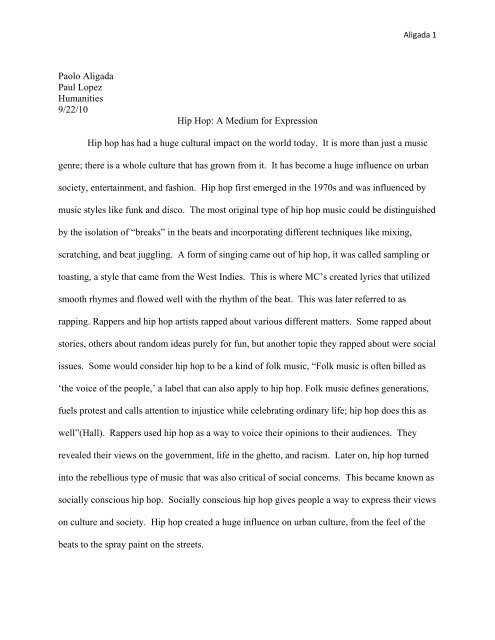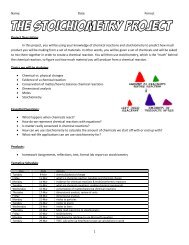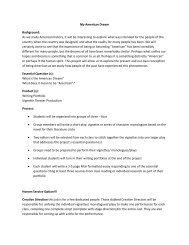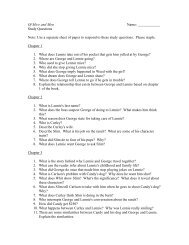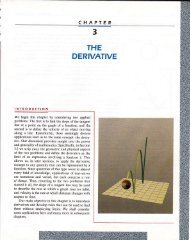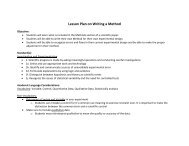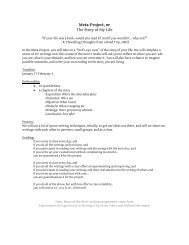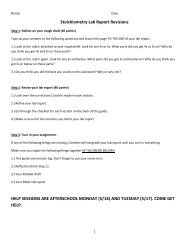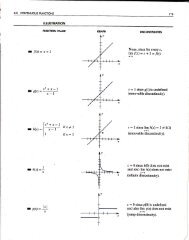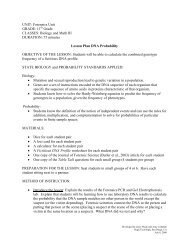Paolo Aligada Paul Lopez Humanities 9/22/10 Hip Hop: A Medium ...
Paolo Aligada Paul Lopez Humanities 9/22/10 Hip Hop: A Medium ...
Paolo Aligada Paul Lopez Humanities 9/22/10 Hip Hop: A Medium ...
Create successful ePaper yourself
Turn your PDF publications into a flip-book with our unique Google optimized e-Paper software.
<strong>Paolo</strong> <strong>Aligada</strong><br />
<strong>Paul</strong> <strong>Lopez</strong><br />
<strong>Humanities</strong><br />
9/<strong>22</strong>/<strong>10</strong><br />
<strong>Hip</strong> <strong>Hop</strong>: A <strong>Medium</strong> for Expression<br />
<strong>Aligada</strong> 1<br />
<strong>Hip</strong> hop has had a huge cultural impact on the world today. It is more than just a music<br />
genre; there is a whole culture that has grown from it. It has become a huge influence on urban<br />
society, entertainment, and fashion. <strong>Hip</strong> hop first emerged in the 1970s and was influenced by<br />
music styles like funk and disco. The most original type of hip hop music could be distinguished<br />
by the isolation of “breaks” in the beats and incorporating different techniques like mixing,<br />
scratching, and beat juggling. A form of singing came out of hip hop, it was called sampling or<br />
toasting, a style that came from the West Indies. This is where MC’s created lyrics that utilized<br />
smooth rhymes and flowed well with the rhythm of the beat. This was later referred to as<br />
rapping. Rappers and hip hop artists rapped about various different matters. Some rapped about<br />
stories, others about random ideas purely for fun, but another topic they rapped about were social<br />
issues. Some would consider hip hop to be a kind of folk music, “Folk music is often billed as<br />
‘the voice of the people,’ a label that can also apply to hip hop. Folk music defines generations,<br />
fuels protest and calls attention to injustice while celebrating ordinary life; hip hop does this as<br />
well”(Hall). Rappers used hip hop as a way to voice their opinions to their audiences. They<br />
revealed their views on the government, life in the ghetto, and racism. Later on, hip hop turned<br />
into the rebellious type of music that was also critical of social concerns. This became known as<br />
socially conscious hip hop. Socially conscious hip hop gives people a way to express their views<br />
on culture and society. <strong>Hip</strong> hop created a huge influence on urban culture, from the feel of the<br />
beats to the spray paint on the streets.
<strong>Aligada</strong> 2<br />
<strong>Hip</strong> hop originated in New York City, more specifically in the Bronx. It began to come<br />
into the spotlight during the 1970s. There was a large African American and Afro-Caribbean<br />
community in the Bronx, so a lot of the influence on hip hop came from there. It was mostly the<br />
youth culture that was involved with it. This community and culture introduced a lot of new and<br />
contemporary ideas into the community, like getting out of the streets and turning toward non-<br />
violent, non-illegal activities. This made the originality of hip hop all the more unique. <strong>Hip</strong> hop<br />
started to get popular when DJ’s hosted block parties and numerous people would flock toward<br />
the buildings with the thumping music. DJ’s used these gatherings as a way for kids to get out of<br />
the streets and give them a way to express themselves without resulting to gangs and violence;<br />
basically a place where they could get away. This was one of the first reasons why hip hop<br />
started.<br />
Some DJ’s that were considered the forefathers of hip hop were: DJ Clive “Kool Herc”<br />
Campbell, Afrika Bambaataa, and Grandmaster Flash. They were the originators; their influences<br />
drew a structure for the hip hop culture. Afrika Bambaataa was a key figure, he established the<br />
“Four Elements of <strong>Hip</strong> <strong>Hop</strong>” which consisted of MCing, DJing, B-boying, and graffiti writing.<br />
MCing is when people “sing” in rhymes that go with the rhythm of the music. This is known as<br />
sampling, or later referred to as rapping. DJing (Disc Jockeying) are the people who make the<br />
music by mixing songs and adding their own style to the beat like scratching, and “juggling.” B-<br />
boying (break-dancing), the B standing for break, is the physical art branch of hip hop. The term<br />
Break-dancing came from the “breaks” and isolations that were in the songs DJ plays. They<br />
used the “break” as an opportunity to hit hard with their dance moves. Graffiti writing and street<br />
art became the visual art section of hip hop. Graffiti writers would go out and put up their art in<br />
public places like subways and empty walls. “Tagging” later emerged out of graffiti where
<strong>Aligada</strong> 3<br />
people would write their tagging name on various places. These pillars became the foundation of<br />
hip hop culture.<br />
<strong>Hip</strong> hop did not just appear out of nowhere into the urban scene, but rather the music<br />
evolved from older styles of music like funk and disco. James Brown is even considered a part<br />
of the hip hop ancestry. What inspired people toward the hip hop culture was the opportunity to<br />
get out of the streets, forget about the hard lives they had, and just be able to have fun and<br />
express themselves. A large component to the popularity of hip hop was social class. The<br />
majority of the people involved in the hip hop movement when it started back in the 70s were<br />
mainly lower class, Black Americans. Living in the Bronx, it gave them something that they<br />
could relate to and be a part of. You don’t need to fall under a certain category. It’s something<br />
that does not discriminate.<br />
In the late 1800s and early 1900s more and more immigrants moved into New York;<br />
Irish, Jewish, and Italian communities developed. However more and more diversity began to<br />
appear in New York with the rise of the Great migration, African Americans moving north from<br />
the south, and the Harlem Renassaince. Afro-Carribean and Hispanic communities also began to<br />
form in New York. The Bronx became the third-most-densely-populated county in the United<br />
States. After the Great Depression, the Bronx went through hard times in recovery. In the<br />
1950s, the once middle class county turned to a lower class area. Through the 1970s, living in<br />
these urban ghettos were hard. It was very easy for young people to get involved in gangs and<br />
violence as a way to feel wanted and accepted, but there were better ways of being someone than<br />
resorting to violence. DJ Clive “Kool Herc” Campbell, an immigrant from Jamaica began to<br />
host block parties where hundreds of people would come and he would play his beats loud for<br />
the whole neighborhood to hear. The parties would be filled with dancing, which was where
<strong>Aligada</strong> 4<br />
break-dancing was born. There were a lot of non-violent competition between MC’s, DJ’s, and<br />
b-boys. <strong>Hip</strong> hop became a way for the youth culture to express themselves through dance, music<br />
and art. It was a way for people to get away from the streets, forget about their hardships, and<br />
basically have a good time. It is probably safe to say that this is where hip hop began to bloom.<br />
<strong>Hip</strong> hop is definitely one of the fastest growing social movements in history; only 40<br />
years ago beats were being played on private sound systems, now it is a worldwide phenomenon.<br />
“Its influence on western society is far reaching and hip hop is often referred to as a<br />
‘culture’”(Smith). <strong>Hip</strong> hop culture is seen everywhere, from entertainment, to fashion, to<br />
language. <strong>Hip</strong> hop has now become implanted in western culture, more specifically in the<br />
United States. By the 1980s, hip hop and rap was booming across the nation. One song that is<br />
said to have introduced the world to rap was “Rapper’s Delight” by the Sugarhill Gang. This<br />
was an important event in hip hop history, this placed hip hop in the world spotlight. <strong>Hip</strong> hop<br />
and rap just kept growing and growing in popularity. MC’s were later referred to as rappers, and<br />
they rapped about a wide variety of issues. However hip hop was no longer just for having fun<br />
and dancing around, it turned into a way of expressing their views and opinions on cultural<br />
issues like the life in the ghetto, government/the police, and gangs.<br />
<strong>Hip</strong> <strong>Hop</strong> culture when resolutely cultivated, potentially serves as a redemptive<br />
artistic and intellectual vantage point from which the socio-politically oppressed,<br />
the culturally marginalized . . . the globally dispossessed, the racially outcast . . .<br />
the wretched of the earth . . . can critically engage an oppressive society (Stover).<br />
This is considered socially conscious hip hop. This was mostly articulated through graffiti and<br />
rapping. One of the earliest examples of socially conscious hip hop was the song “The Message”<br />
by Grandmaster Flash and the Furious Five. This song demonstrated how life was to live in the<br />
lower class, the ghetto, and dealing with the police. This was a turning point in hip hop. The
lyrics that artists use can have a great influence on its audience. “Gangsta” rap emerged as a<br />
huge sub genre from hip hop. This style of rap consisted of explicit language, promoting of<br />
<strong>Aligada</strong> 5<br />
violence, and rebelling against police. N.W.A. was an example of this. The youth who listen to<br />
this music are given the idea that this kind of lifestyle is cool; being in a gang is how you become<br />
someone. It is ironic how hip hop was originally made to give people a way to escape the gang<br />
life and it headed back in the direction that it was trying to avoid. Afrika Bambaataa was the<br />
founder of the organization the Zulu Nations, a hip hop awareness group. Their mission to help<br />
lead gangsters out of lives of crime for positive change. However people do whatever they want.<br />
The hip hop culture is very contemporary and has some controversy. “<strong>Hip</strong> hop is still an infant.<br />
It’s not accepted by a lot of people.....It’s a scapegoat for a lot of people”(Campbell “DJ Kool<br />
Herc”). The violent lyrics used in hip hop is probably the reason for censorship on a lot of hip<br />
hop albums and also why people shun hip hop. They usually affiliate it with gangsters, violence<br />
and profanity.<br />
<strong>Hip</strong> hop has had many effects on society. Being a music genre, whatever they sing or rap<br />
about are straight into the minds of the audience. Some researchers believe that hip hop and the<br />
violent lyrics that is in it may have a relation to the rising crime rates in cities. According to<br />
recent youth violence statistics done by the Josephson Institute:<br />
• Large cities claim that 72% of their school violence is attributable to gang activity.<br />
• Between 1986 and 1992, the total number of children killed by firearms rose by 144<br />
percent.
<strong>Aligada</strong> 6<br />
• From 1985 to 1993, murders committed by people over age 25 dropped 20 percent; but<br />
they increased 65 percent among 18- to 24-year-olds and increased 165 percent among<br />
14- to 17-year-olds.<br />
The research suggests that the link between hip hop and violence is not coincidental. As<br />
hip hop music grew in popularity, the crime rate grew as well. However not all hip hop must<br />
have a negative influence. The kids who listen to these artists can also see them as role models.<br />
“Many hip hop artists did not come from privileged backgrounds but showcase to youth that they<br />
can achieve their goals”(Hall). There are many artists who want to promote good and positive<br />
meaning through their music such as the Fresh Prince of Bel-air, and The Sugar hill Gang. This<br />
genre has many sides and aspects to it.<br />
<strong>Hip</strong> hop has been around for a good while now and its effects on society have been<br />
plenty. Society has been greatly influenced by this movement. It is resembled through the urban<br />
culture. It is seen through demeanor, fashion, music and dance. <strong>Hip</strong> hop all in all is a medium<br />
for expression. Whether it be to show off style, or speak out on heated issues. Overall hip hop is<br />
very unique in comparison to other social movements. It wasn’t so much to fight against the<br />
norm or rebel against higher powers, it was simply a way to escape from the hardships of the<br />
world and express individuality. It can’t be denied that hip hop has had its non-reputable sides,<br />
but when you look at the big picture, people did it with a passion that can’t be described.<br />
Whether it be rapping, dancing, or spray painting a piece of wall, hip hop will be around for a<br />
long time to come.
Works cited<br />
"AFRIKA BAMBAATAA INTERVIEW | East-3.com." East-3.com | . Web. 16 Sept. 20<strong>10</strong>.<br />
.<br />
"An Interview W/Kool Herc-Father of <strong>Hip</strong> <strong>Hop</strong> - <strong>Hip</strong> <strong>Hop</strong> Artists Interview Archive - <strong>Hip</strong> <strong>Hop</strong><br />
<strong>Aligada</strong> 7<br />
News, Views and Activism." Davey D's <strong>Hip</strong> <strong>Hop</strong> Political Palace - Message Board. Web.<br />
24 Sept. 20<strong>10</strong>. .<br />
Case, Henry. "The Social Impact of <strong>Hip</strong> <strong>Hop</strong> in America - by Henry Case -<br />
Helium." Helium. Web. 16 Sept. 20<strong>10</strong>. .<br />
"Interview with Dr.Dre." Dr. Dre News and Information, Lyrics, Pictures. Web. 24 Sept. 20<strong>10</strong>.<br />
.<br />
Keeley, Jennifer. Rap Music. San Diego, CA: Lucent, 2001. Print.<br />
"NWA - STRAIGHT OUTTA COMPTON LYRICS." Lyrics. Web. 24 Sept. 20<strong>10</strong>.<br />
.<br />
"The Message Lyrics - Grandmaster Flash." Lyrics, Song Lyrics – LyricsFreak.com. Web. 24<br />
Sept. 20<strong>10</strong>. .<br />
"The Rough Guide to <strong>Hip</strong>-hop (Rough Guide Music CDs): Amazon.co.uk: Peter Shapiro:<br />
Books."Amazon.co.uk: Low Prices in Electronics, Books, Sports Equipment & More.<br />
Web. 01 Oct. 20<strong>10</strong>. .<br />
Smith,, Katie. "The Influence of <strong>Hip</strong> <strong>Hop</strong> Music on Society | EHow.com." EHow. Web. 16 Sept.<br />
20<strong>10</strong>. .<br />
Woodstra, Chris, John Bush, and Stephen Thomas. Erlewine. Old School Rap and <strong>Hip</strong>-hop.<br />
New York: Backbeat, 2008. Print.


